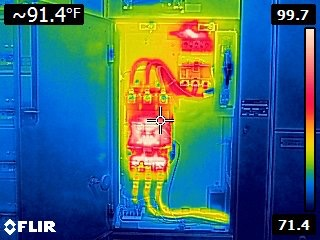Third Party Evaluations





Description
The National Electrical Code, NEC (NFPA 70) Article 110.2, requires that electrical equipment be approved by the AHJ (the Authority Having Jurisdiction, who is usually the local electrical inspector). Since the AHJ’s scope is limited to NEC interpretations, this means only equipment that is Listed or Labeled and suitable for the installation can be approved. Listing and labeling indicates testing and monitoring by a Nationally Recognized Testing Laboratory [NRTL], such as the well recognized Underwriters Laboratories, or UL. UL is both a testing laboratory and a standards-writing body. There are other laboratories as well, such as FM, ETL, CSA, and MET.
The CE Mark
Is the CE mark acceptable? It is not, as the CE mark is unrelated to the requirements of product safety in the US. It is a generic mark in the European Union [EU] that indicates the product meets EU standards. The CE mark can be self-certified by the manufacturer. However, the CE mark does indicate some level of adherence to standards of safety and quality. Equipment manufactured in Europe and Asia is often deficient in short circuit withstand capacity, as the available short circuit current available in North America is substantially greater than in other parts of the world.
Minnesota Standards
In the mid-1980s the State Board of Electricity adopted provisions specified in Minnesota Rule 3801.3620, Approval of Electrical Equipment for listing and labeling alternatives and exemptions. Exemptions include assemblies supplied by listed Class 2, logic level, communications, or other low voltage sources, or fewer than eight listed or labeled components in a listed enclosure.
Qualified Evaluators
Field evaluations can be executed by one of the NRTLs or by a qualified registered or licensed electrical engineer. (Note: To lawfully practice engineering in Minnesota the engineer must be licensed in Minnesota.) Hedstrom Engineering is qualified and licensed for these evaluations and has completed hundreds of favorable reports accepted by AHJs across the state of Minnesota. Other states that allow alternatives to NRTL include North Dakota, Washington, Oregon and California.
The Evaluation Process
Equipment can be evaluated at either the manufacturer’s location or the end user’s site. The latter is more common as the owner often first discovers the need for an evaluation at the time an AHJ is finalizing the permit inspection. It is helpful, but not necessary to review the drawings before visiting the site for an evaluation. Hedstrom Engineering works with the manufacturer when possible to determine which if any electrical safety standards were used in the design and construction of the equipment.
Minnesota Rule 3801.3620 leaves the selection of a safety standard to the judgment of the evaluator. If a relevant safety standard is not identified by the manufacturer, Hedstrom Engineering selects the most appropriate standard. Often that is NFPA 79, Electrical Standard for Industrial Machinery. Sometimes the equipment might not fit the precise definition of industrial machinery, but the design standard format of NFPA 79 provides better guidance. A design standard such as NFPA 79 states clearly how equipment should be constructed and wired. UL Standards, in contrast, specify testing regimes intended to stress the equipment to limits to ascertain safety and suitability. Rule 3801.3620 does not explicitly require testing. Performance standards provide little guidance when evaluating by examination.
Evaluation Report
After examining the equipment, Hedstrom Engineering generates a remediation letter if needed, outlining any deficiencies or substandard construction. Hedstrom endeavors to suggest cost effective solutions for each item on the remediation letter, and works with the electrical contractor or other qualified persons to bring the equipment into compliance. When changes or remediations are extensive, a follow-up examination may be necessary. In some cases components of the equipment may be safe, but not readily recognized as acceptable, and no suitable means of substitution or change are practical. In these cases Hedstrom gathers the available evidence and constructs a supportable justification for the discrepancy.
When the equipment is acceptable, Hedstrom Engineering issues a report of findings to the Department of Labor and Industry (formerly the State Board of Electricity) in state-inspected areas, or to the AHJ for locally inspected municipalities. These reports are always favorable, as Hedstrom has already recommended and the client completed needed corrections.
Fees
Third party evaluations are fee-for-service, but the report and its submission are at a flat rate. Depending upon the complexity of the equipment, quality of the documentation, ease of access, and execution of the wiring and construction, the initial evaluation can take two to eight hours. A remediation letter may take another one to five hours.
More Information
More information can be found on the Minnesota Department of Labor and Industry website.
NEC Article 100, Definitions:
- Approved. Acceptable to the authority having jurisdiction.
- Listed. Equipment, materials, or services included in a list published by an organization that is acceptable to the authority having jurisdiction and concerned with evaluation of products or services, that maintains periodic inspection of production of listed equipment or materials or periodic evaluation of services, and whose listing states that either the equipment, material, or service meets appropriate designated standards or has been tested and found suitable for a specified purpose.
- Labeled. Equipment or materials to which has been attached a label, symbol, or other identifying mark of an organization that is acceptable to the authority having jurisdiction and concerned with product evaluation, that maintains periodic inspection of production of labeled equipment or materials, and by whose labeling the manufacturer indicates compliance with appropriate standards or performance in a specified manner.